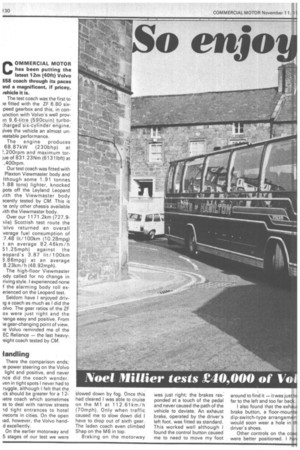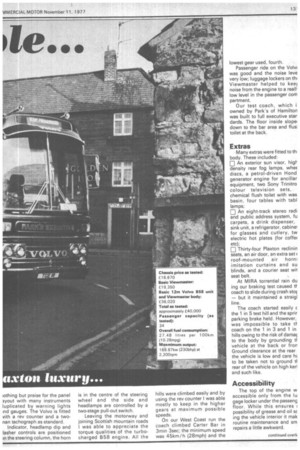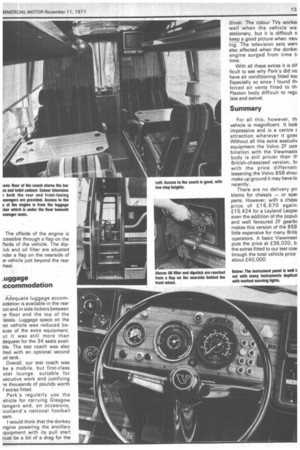enjos
Page 132

Page 133

Page 135

If you've noticed an error in this article please click here to report it so we can fix it.
COMMERCIAL MOTOR has been putting the latest 12m (40ft) Volvo 358 coach through its paces ind a magnificent, if pricey, rehicle it is.
The test coach was the first to )e fitted with the ZF 6.80 sixpeed gearbox and this, in conunction with Volvo's well provm 9.6-litre 1590cuin) turbo-_ :harged six-cylinder engine, lives the vehicle an almost uneatable performance.
The engine produces 68.87kVV (230bhp) at !,200rpm and maximum tor'Lie of 831.23Nm (6131Ibft) at ,40Orpm.
Our test coach was fitted with Plaxton Viewmaster body and lthough some 1.91 tonnes 1.88 tons) lighter, knocked pots off the Leyland Leopard vith the Viewmaster body Dcently tested by CM. This is ie only other chassis available fith the Viewmaster body.
Over our 1171.2km (727.9iile) Scottish test route the 'olvo returned an overall verage fuel consumption of 7.48 lit/100km (10.28mpg) t an average 82.46km /h 51.25mph) against the eopard's 3.87 lit/100km 3.86mpg) at an average 8.23km/h (48.92mph).
The high-floor Viewmaster ody called for no change in riving style. I experienced none f the alarming body roll exerienced on the Leopard test. Seldom have I enjoyed drivig a coach as much as I did the olvo. The gear ratios of the ZF ox were just right and the iange easy and positive. From le gear-changing point of view, le Volvo reminded me of the EC Reliance — the last heavy'eight coach tested by CM.
landling
There the comparison ends; )e power steering on the Volvo light and positive, and never nce did the coach wander. ven in tight spots I never had to ruggle, although I felt that the, ck should be greater for a 12'etre coach which sometimes 3S to deal with narrow streets id tight entrances to hotel irecorts in cities. On the open lad, however, the Volvo handd excellently.
On the earlier motorway and 5 stages of our test we were slowed down by fog. Once this had cleared I was able to cruise on the M1 at 112.61km/h (70mph). Only when traffic caused me to slow down did I have to drop out of sixth gear. The laden coach even climbed Shap on the M6 in top.
Braking on the motorway was just right; the brakes responded at a touch of the pedal and never caused the path of the vehicle to deviate. An exhaust brake, operated by the driver's left foot, was fitted as standard. This worked well although I found the control button caused me to need to move my foot around to find it — it was just to far to the left and too far back.
I also found that the exhato brake button, a floor-mounte dip-switch-type arrangemen. would soon wear a hole in th driver's shoes.
Other controls on the coac were better positioned. I hay
iothing but praise for the panel 3yout with many instruments luplicated by warning lights Ind gauges. The Volvo is fitted vith a rev counter and a twonan tachograph as standard.
Indicator, headlamp dip and lasher controls are positioned m the steering column, the horn is in the centre of the steering wheel and the side and headlamps are controlled by a two-stage pull-out switch.
Leaving the motorway and joining Scottish mountain roads I was able to appreciate the torque qualities of the turbocharged B58 engine. All the hills were climbed easily and by using the rev counter I was able mostly to keep in the higher gears at maximum possible speeds.
On our West Coast run the coach climbed Carter Bar in 3min 3sec; the minimum speed was 45km th (28mph) and the lowest gear used, fourth.
Passenger ride on the Volvc was good and the noise leve very low; luggage lockers on thi Viewmaster helped to keel noise from the engine to a real'. low level in the passenger corn partment.
Our test coach, which i owned by Park's of Hamilton was built to full executive star dards. The floor inside slope' down to the bar area and flusl toilet at the back.
Extras
Many extras were fitted to th. body. These included: An exterior sun visor, higF density rear fog lamps, wheE discs, a petrol-driven Hond generator engine for ancillar equipment, two Sony Trinitro colour television sets, chemical flush toilet with was basin, four tables with tabl lamps;
E An eight-track stereo radi and public address system, fu carpets, a drink dispenser, sink unit, a refrigerator, oabinei for glasses and cutlery, tw electric hot plates (for coffei etc);
E Thirty-four Plaxton reclinin seats, an air door, an extra set roof-mounted air horn; imitation curtains and su blinds, and a courier seat wil seat belt.
At MIRA torrential rain du ing our braking test caused coach to slide during crash stof — but it maintained a straigl line.
The coach started easily c the 1 in 5 test hill and the sprir parking brake held. However, was impossible to take IF coach on the 1 in 3 and 1 in hills owing to the risk of damac. to the body by grounding tt vehicle at the back or fron Ground clearance at the rear the vehicle is low and care hi to be taken not to ground tl rear of the vehicle on high kenl and such like.
Accessibility
The top of the engine w accessible only from the lu gage locker under the passeng floor. While this ensures possibility of grease and oil sc ing the vehicle interior it mak routine maintenance and sm repairs a little awkward. The offside of the engine is 3cessible through a flap on the Ffside of the vehicle. The dipick and oil filter are situated nder a flap on the nearside of le vehicle just beyond the rear heel.
.uggage iccommodation
Adequate luggage accomiodation is available in the rear Dot and in side lockers between le floor and the top of the lassis. Luggage space on the rst vehicle was reduced be use of the extra equipment, ut it was still more than dequate for the 34 seats availble. The test coach was also tted with an optional second Jel tank.
Overall, our test coach was ke a mobile, but first-class otel lounge, suitable for xecutive work and justifying le thousands of pounds worth f extras fitted.
Park's regularly use the ehicle for carrying Glasgow langers and, on occasions, icotland's national football aam.
I would think that the donkey :ngine powering the ancillary :quipment with its pull start nust be a bit of a drag for the driver. The colour TVs worker well when the vehicle wa: stationary, but it is difficult tr keep a good picture when mov ing. The television sets wer( also affected when the donke, engine surged from time ti time,
With all these extras it is dif ficult to see why Park's did no have air conditioning fitted too Especially so since I found thi forced air vents fitted to th, Plaxton body difficult to regu late and Swivel.
Summary
For all this, however, th vehicle is magnificent. It look impressive and is a centre c attraction wherever it goes Without all this extra executiv equipment the Volvo ZF conr bination with the ViewmastE body is still pricier than tiBritish-chassised version, bi with the price differneti; lessening the Volvo B58 shou make up ground it may have lo recently.
There are no delivery or( blems for chassis — or spai parts. However, with a chass price of £16,670 again: £15,424 for a Leyland Leopar even the addition of the popul: and well favoured ZF gearbc makes this version of the B58 little expensive for many Britis operators. A basic Viewmast puts the price at £36,020, b the extras fitted to our test cow brough the total vehicle price about £40,000.
















































































































































































































































